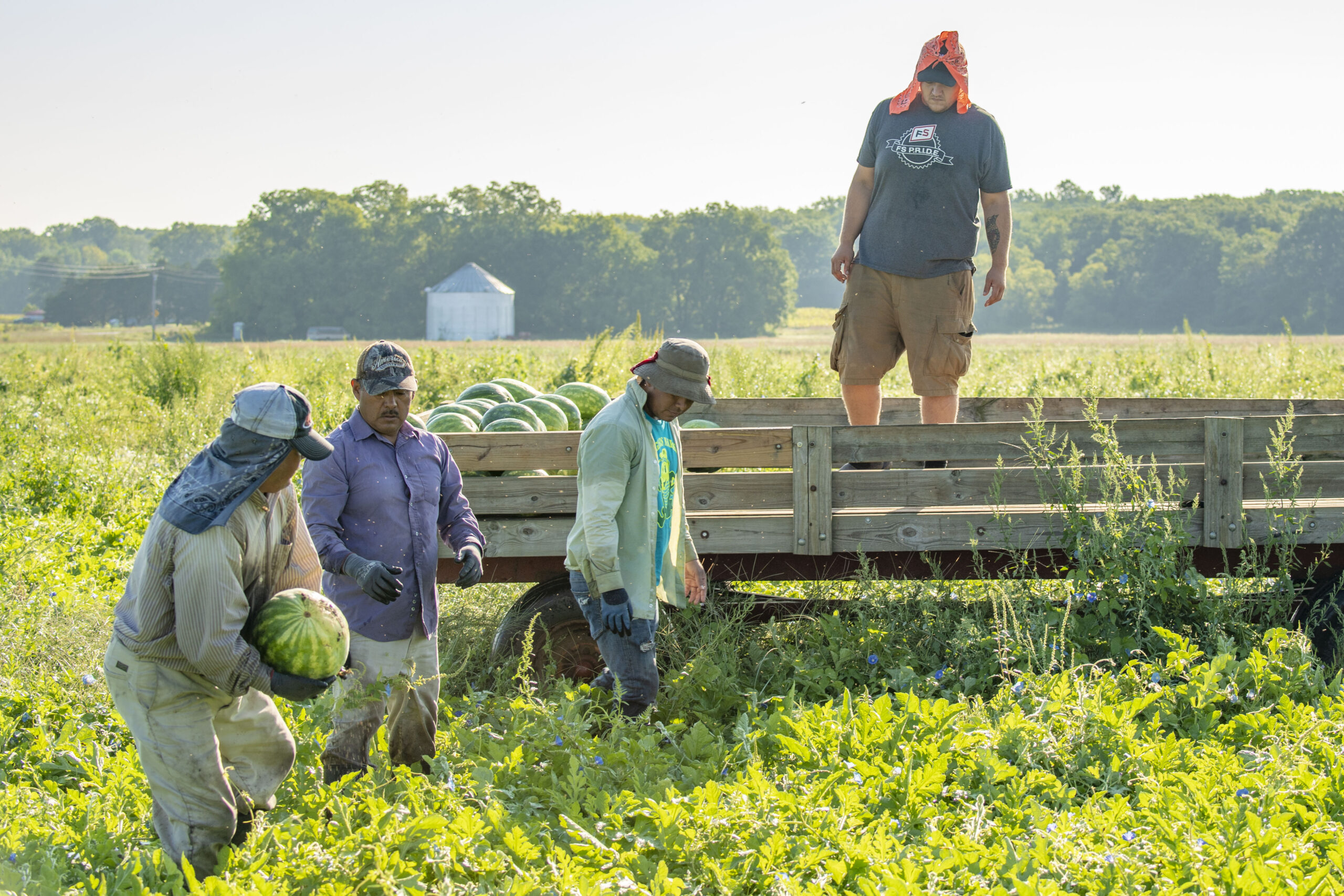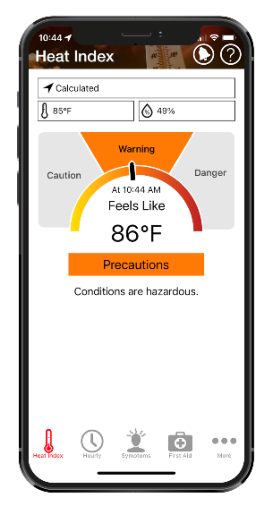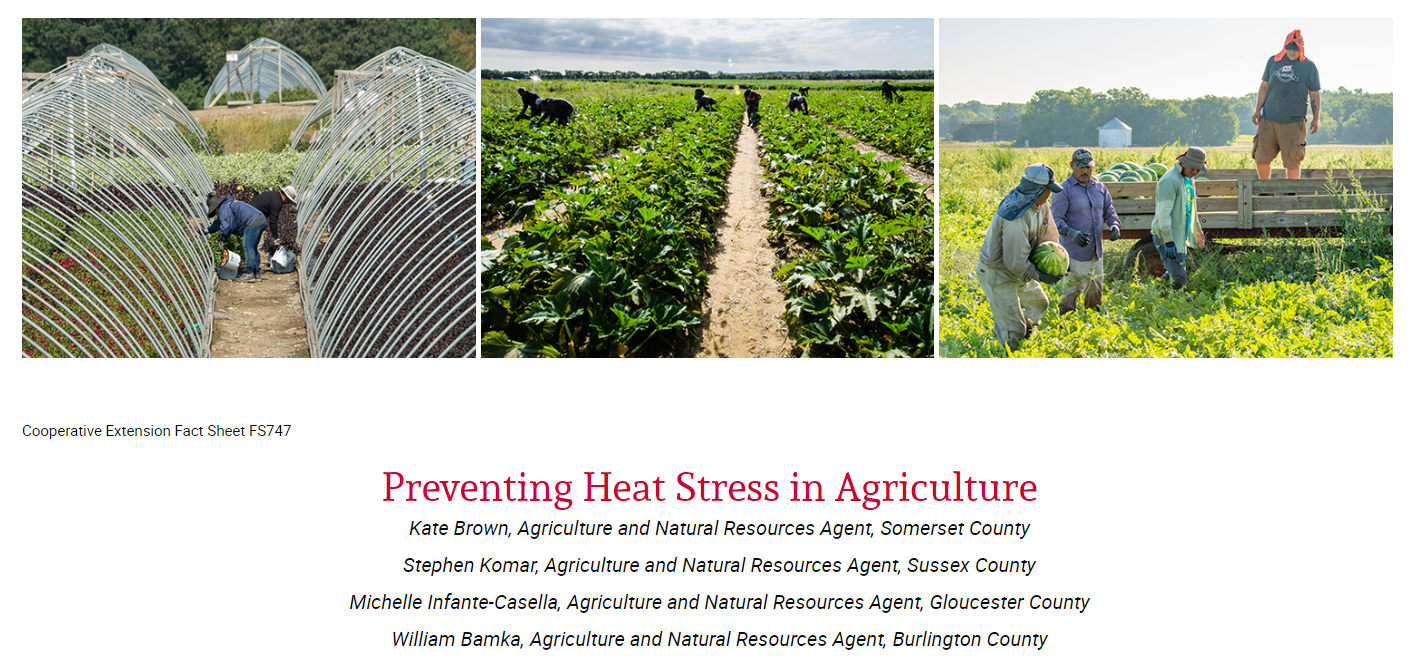The Rutgers NJAES factsheet on “Preventing Heat Stress in Agriculture” has been updated and is now available at https://njaes.rutgers.edu/FS747/. The factsheet provides basic knowledge about heat stress, first-aid treatment, and preventative measures that are important to both agricultural employers and workers. As the temperatures warm up, it’s time to get prepared for working in the heat!
Beat the Heat: Recognize Signs of Heat Illness
Several types of heat-related illnesses can affect workers and symptoms may be non-specific. When a worker is performing physical labor in warm environments, any unusual symptom may be a sign of heat illness. The chart below from OSHA outlines symptoms and signs that may indicate heat stress. Note that common signs and symptoms include muscle pain, weakness or fatigue, dizziness, heavy sweating, and rapid heart rate.
|
Heat-Related Illness |
Symptoms and Signs |
|
Heat stroke |
|
| Heat exhaustion |
|
| Heat cramps |
|
| Heat syncope |
|
| Heat rash |
|
| Rhabdomyolysis (muscle breakdown) |
|
Employers and workers should become aware of symptoms related to heat stress and heat illness. In addition, knowing what to do when someone is showing signs of heat illness is very important. This resource from NIOSH describes the appropriate first aid for each of these illnesses. Prompt action to provide first aid can make a difference in recovery of persons with heat illness. Multiple heat-related illnesses can occur together, and time is of the essence.
When in doubt, place the worker in a cool environment and call 911.
Beat the Heat: Hydration is Key
The body uses water to help dissipate heat through sweat and evaporation of sweat. Water lost as sweat must be replaced through water consumption to help the body maintain temperature regulation. During moderate activity, the CDC recommends drinking at least 1 cup of water every 15-20 minutes to replace water lost through sweat.
Sports drinks are likely unnecessary to replenish the body’s electrolytes when adequate hydration is combined with regular meals. However, sports drinks may be beneficial to help balance the body’s water and electrolytes when tasks conducted under hot temperatures result in prolonged sweating over several hours.
Limit consumption of energy drinks, alcohol, and caffeine-containing beverages such as coffee, tea, and soda. These beverages can contribute to dehydration, increasing the risk of heat illness.
Staying hydrated starts before work then continues throughout the day and after work. Attention to personal hydration decreases the risk of heat illness and other risks associated with chronic dehydration, such as kidney stones.

Webinars: Don’t Sweat Heat Stress in Agriculture
The New Jersey Legislature is currently reviewing identical bills (A3521/S2422) which would establish an occupational heat stress standard and “Occupational Heat-Related Illness and Injury Prevention Program” under the NJ Department of Labor and Workforce Development. As we monitor the progress of these bills, the Farm Health and Safety Working Group of Rutgers Cooperative Extension has launched an educational program on heat stress mitigation in agriculture which includes weekly “Beat the Heat” articles published in the Rutgers Plant and Pest Advisory E-Newsletter, an update to the Rutgers factsheet “Preventing Heat Stress in Agriculture” and a webinar series.

USDA photo by Preston Keres.
In partnership with New Jersey Farm Bureau, we invite you to join us for a two-part webinar series titled “Don’t Sweat Heat Stress in Agriculture”.
- Wednesday, June 5 from 7:00-8:00 PM
- An introduction to heat stress issues in agriculture. We will also share tools farmers can use to evaluate heat risk and recommended resources for guidance on heat stress prevention.
- Wednesday, June 12 from 7:00-8:00 PM
- An overview on signs of heat stress and corresponding first aid, as well as strategies for heat stress prevention. A panel of farmers will discuss their currently used strategies for employee management during periods of high heat.
You must register to attend these webinars by visiting https://go.rutgers.edu/heat-stress-in-ag.
Questions? Contact Kate Brown, County ANR Agent with RCE-Somerset County, at 908-526-6293 x4 or kbrown@njaes.rutgers.edu.
Beat the Heat: Tools for Evaluating Heat Risk

Heat safety tool phone app created by OSHA and NIOSH.
As the weather warms up, prepare yourself to evaluate the heat risk for outdoor tasks. We often use a weather application on our phone to check the daily high and low temperature, but air temperature alone is not sufficient to evaluate heat risk. Heat index is a more appropriate measurement because it combines the effects of air temperature and humidity to indicate the level of discomfort felt by the average person.
One easy way to check the heat index is the Heat Safety Tool phone app (see photo) developed by the Occupational Safety and Health Administration (OSHA) and the National Institute for Occupational Safety and Health (NIOSH). The app calculates heat index at your specific site and displays the risk level to outdoor workers. It also provides insight into protective measures for the given risk level. This mobile phone app is available for both Android and iPhone.
A similar, web-based tool is the HeatRisk website created by the U.S. Centers for Disease Control and Prevention (CDC). The HeatRisk homepage has a color-coded map to indicate today’s heat risk (no risk to extreme risk) for each county in the U.S. You can also enter your zip code to get the daily and 5-day forecasted heat risk for your site plus corresponding actions to reduce heat-related health risks.
Stay tuned for weekly posts on how beat the heat this summer!
Quick Tips to Beat the Heat
Daily high temperatures over the next 10 days will soar above 90 degrees each day, with the real feel exceeding 100 degrees at times. It’s important to take precautions to keep you and your workers safe from heat stress and other heat-related illnesses. Check out these 5 quick tips you can implement today to safeguard everyone on your farm during this extreme heat.

USDA photo by Lance Cheung.
- Stay hydrated. The CDC recommends drinking at least 1 cup of water every 15-20 minutes during moderate activity. For more on hydration, see this factsheet from NIOSH.
- Dress appropriately. Choose light-colored, loose-fitting clothing made of cotton or linen. Protect yourself from the sun with a wide-brimmed hat and sunglasses.
- Acclimatize employees to working in the heat. Gradual exposure to work in a hot environment is critical for both new and experienced employees. To learn more about acclimatization, check out this factsheet from NIOSH.
- Adjust workload. Plan strenuous tasks for cooler parts of the day, increase the number of workers per task to lighten workload, and shorten work periods to allow for breaks in the shade (at least) hourly. NIOSH offers recommendations for work/rest schedules to decrease risk of heat illness in this factsheet.
- Train employees to recognize signs of heat stress. Heat-related illnesses can range from heat rash to heat stroke. Review this NIOSH web page on heat-related illnesses to inform employees about symptoms and first aid response to each illness.

